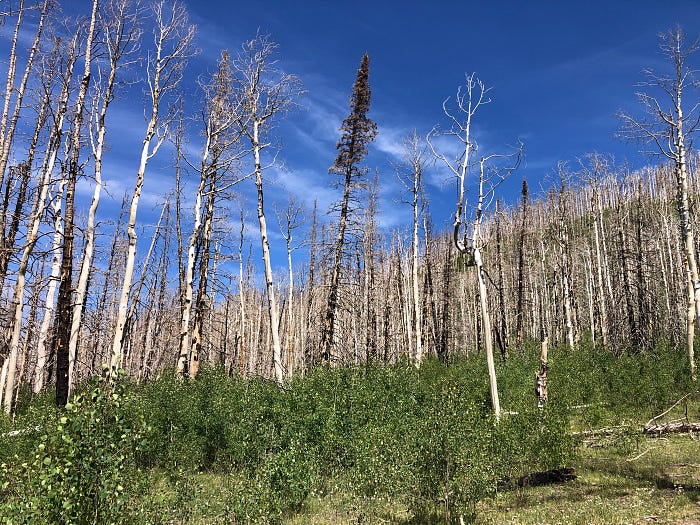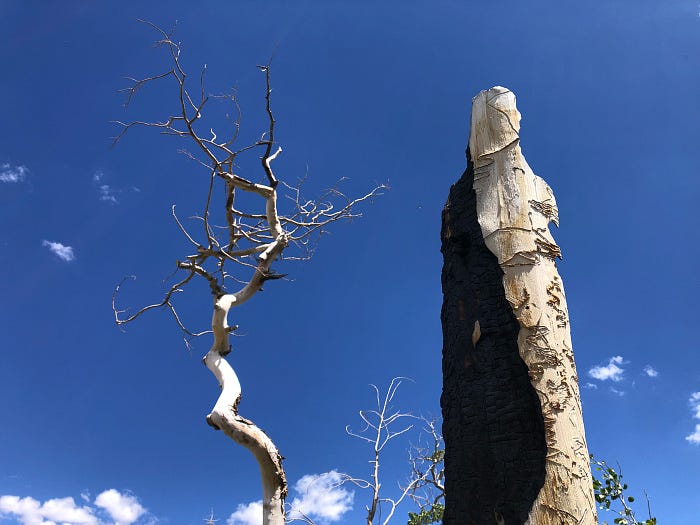

When a Forest Screams
source link: https://robertroybritt.medium.com/when-a-forest-screams-f6ce1d21c24f
Go to the source link to view the article. You can view the picture content, updated content and better typesetting reading experience. If the link is broken, please click the button below to view the snapshot at that time.

When a Forest Screams
A horrifically beautiful mountain landscape decimated by fire emits inexplicably eerie, meaningful cries

DIXIE NATIONAL FOREST, UTAH—Where once a grove of majestic aspens stood, their paper-thin leaves whispering at the slightest summer breeze and shouting the passage of any strong gust, now mostly denuded white and black corpses reach hopelessly skyward, pitifully thin arms outstretched, weakened trunks poised for an inevitable toppling.
All around this high-mountain meadow at midday, a handful of improbably untouched aspens remain, shivering and quaking amid their charred deciduous neighbors, alongside a few brown, scraggly conifer carcasses.
I visualize the long-ago flames, leaping from treetop to treetop, the 2,000-degree heat and smoke creating pyrocumulonimbus clouds that billow into the stratosphere, a “fire tornado” racing across the blackened meadow. I listen for the crackling of that great fire, the sizzle and snap of a forest incinerating.
As I try to imagine the unimaginable, a strong gust crests the ridge to the south and rolls down toward the meadow, and the dead trees begin to scream.
It’s an eerie screech, not unlike a thousand fingernails on chalk or, best I can describe it, a thousand dead souls crying out in a language I don’t understand. The high-pitched, tonally complex scream lasts several seconds, then it’s gone with the gust. I wait and wait in that spot in the meadow but do not hear it again. Did I imagine it? Is there some other explanation, here in a remote meadow at 9,000 feet?
This is a mountain landscape once covered in pine, spruce, fir and aspen, now scorched and decimated. It happens to be in the Dixie National Forest in Utah. But it could be anywhere in the West.

More than 70,000 acres, from 7,000 to 11,000 feet in elevation, were fried to a crisp in the month-long Brian Head Fire five years ago. Thought to have started by illegal weed burning, the wildfire was so intense that much of the soil was subject to severe erosion in subsequent storms, and in other spots the soil became hydrophobic, repelling rains and making recovery difficult for any plant life.
Some $36 million was spent battling the blaze, the most expensive in Utah history at the time. An initial $5.8 million was devoted to restoration of the most critical areas. Then this January — five years on — FEMA pledged another $11 million for restoration of the still-scarred canyons, meadows and mountainsides.
Scenes like this are natural, one might suggest. Forest fires are part of a cycle of death and rebirth. It’s the way of nature. That might’ve once been true, science tells us, back before forest fires burned so hot, so extensively, so thoroughly.
Before us.
A hotter climate is drying out the atmosphere in the Western United States, which leaves vegetation drier, creating the proverbial tinder box. The Brian Head fire was modest in size compared to several other Western wildfires in recent years, including a million-acre blaze in California two years ago.
Wildfire frequency, scope and intensity have all increased rapidly in recent years due in large part to human-caused global warming, according to a study last year in the Proceedings of the National Academy of Sciences.
Similar shifts are stoking greater wildfires around the globe, with worse conditions expected in the years ahead if global warming is not curbed, according to a United Nations report earlier this year.
And there’s a cascading effect of wildfires adding to global warming. Unusual fire activity across boreal forests in Alaska and Canada, in particular risk releasing vast amounts of stored carbon, accelerating climate change, scientists reported this spring in the journal Science Advances.
Still, there’s a strange beauty to the carnage. Works of horrific art, towering temporary installments of monochromatic stick figures framed by a green meadow below and a blue sky above.

Meanwhile, nature is hard at work all around the fringes of the meadow.
The handful of untouched aspens — a solitary survivor here, a row of several there — have tossed down new life, seeding a resurgence of saplings that seek dominance in whatever forest of the future might develop. Aspens are crafty, even sprouting new post-fire growth directly from their roots. Their reemergence is impressive.
Swaths of these fledglings, tall as me, shimmy and sway in unison, more like a hedge than a forest, stretching their young torsos and fluttering their tender leaves like an eaglet eager for first flight, as if practicing to be the quaking giants a forest expects of them.

I spend much of the afternoon wandering around the meadow, hoping to hear that otherworldly scream again. I feel strongly that it was real, some sort of rare acoustical interplay between wind of a certain speed and dead tree branches of a certain size and orientation. That, or I’ve suddenly developed a fantastical imagination and am hearing things.
Later in the afternoon, I walk along one edge of the meadow, which is lined with a mix of live and dead trees, aspen as well as a few conifers that will be much slower to reestablish themselves. A light breeze makes shushing sounds in the few remaining live parental aspens and their restless young below.
Then at some certain wind speed and direction, one dead, spindly aspen sends up a lone cry from its ragged top branches. I can hear it distinctly. I can see where it’s coming from. It’s more of a whistle than a scream, but I can imagine it like the sound of a single flute isolated from a screaming symphony of a thousand horns and strings.
I’m relieved my imagination has not run amok. Sad that the trees had indeed been screaming.
Sunset brings color to the standing corpses, orange and red reflections off bare white bones. Soon the dead aspen are black silhouettes against fading twilight. I remain baffled by the physics of screaming dead trees in this ravaged, beautiful, sad and hopeful former and future forest. But I have a good idea what they were trying to say.

Your support makes my health and science reporting and writing possible. You can sign up to receive an email when I publish a story, or become a Medium member to directly support me and other writers and gain full access to all Medium stories. Also, check out my wellness podcasts at Knowable. — Rob
Recommend
About Joyk
Aggregate valuable and interesting links.
Joyk means Joy of geeK